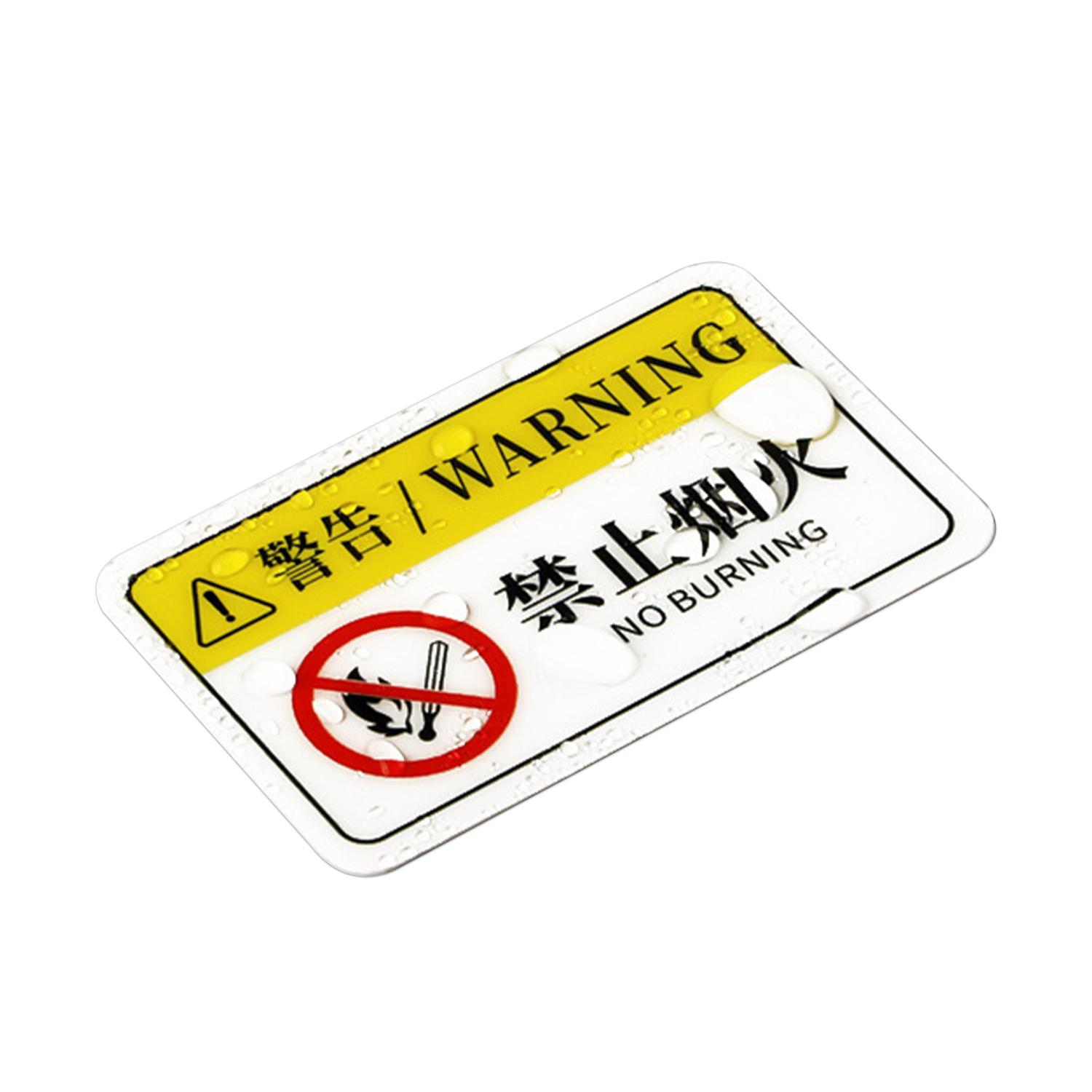
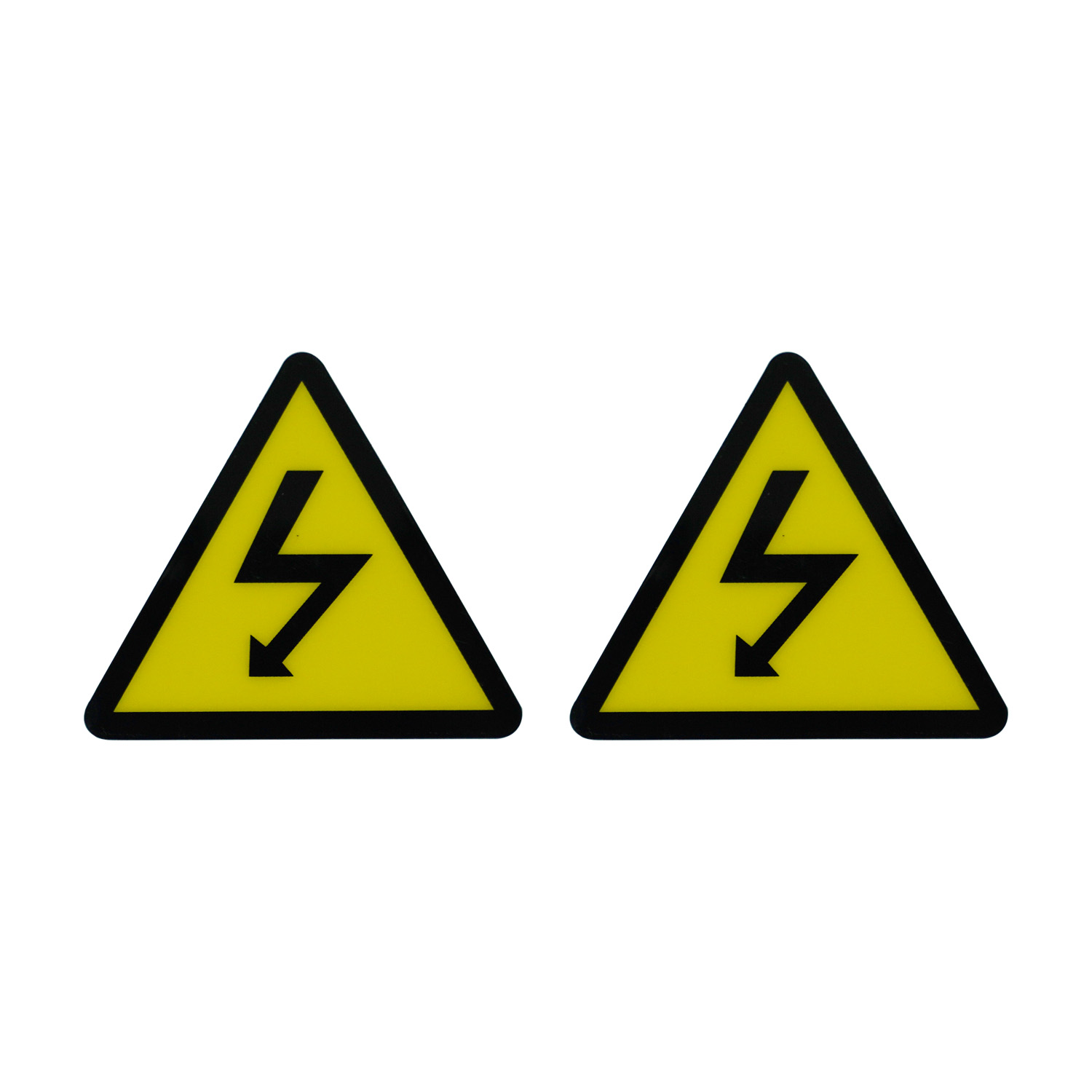
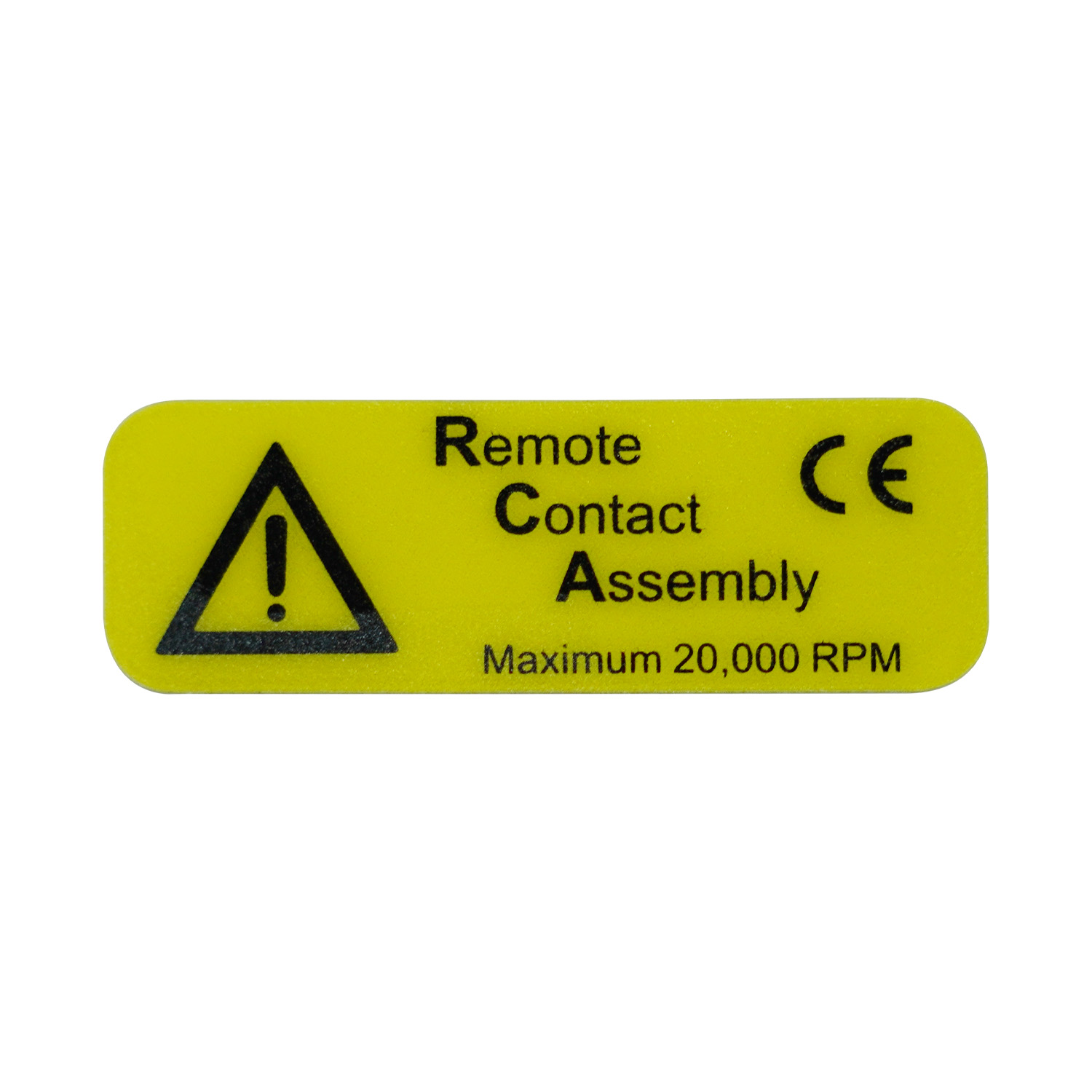
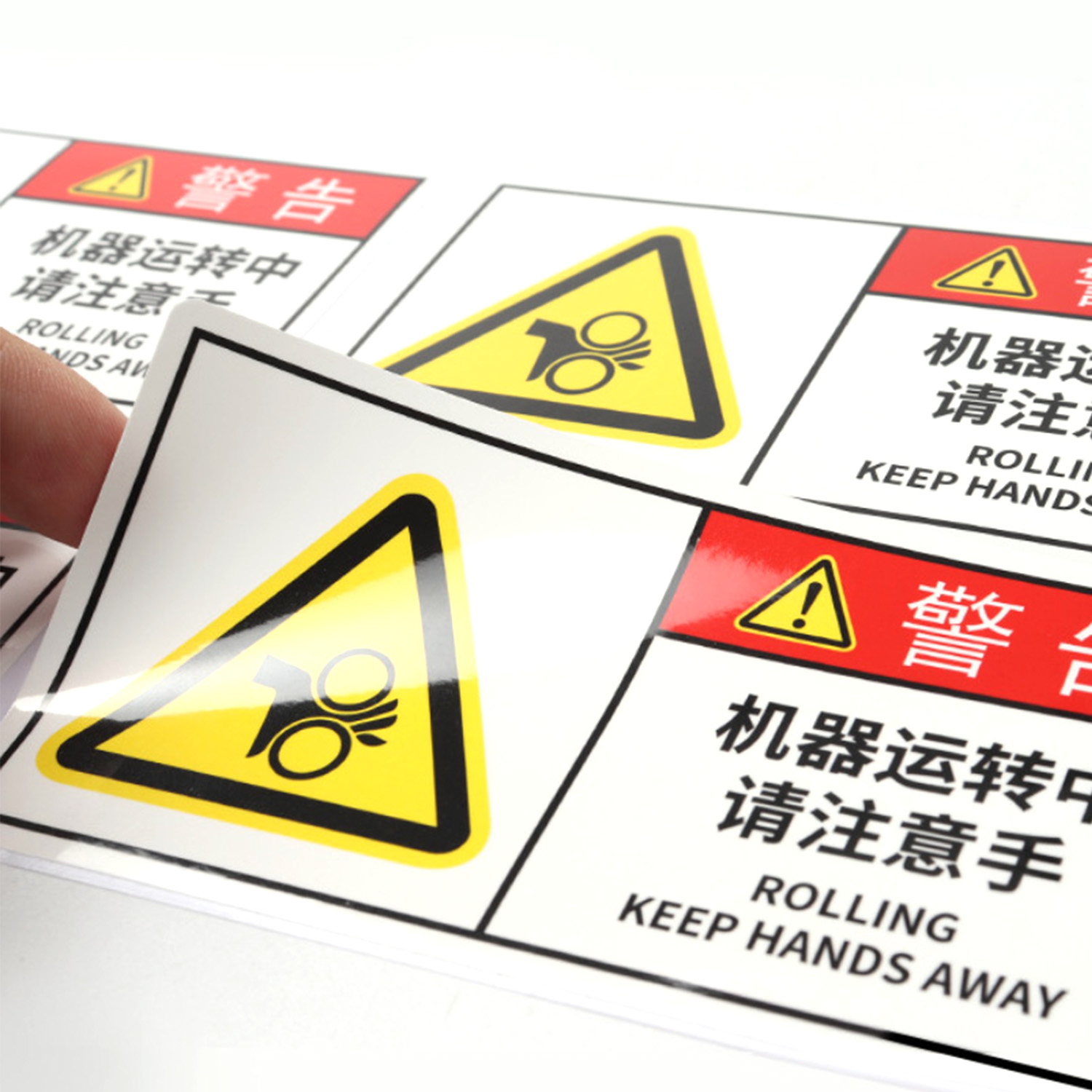
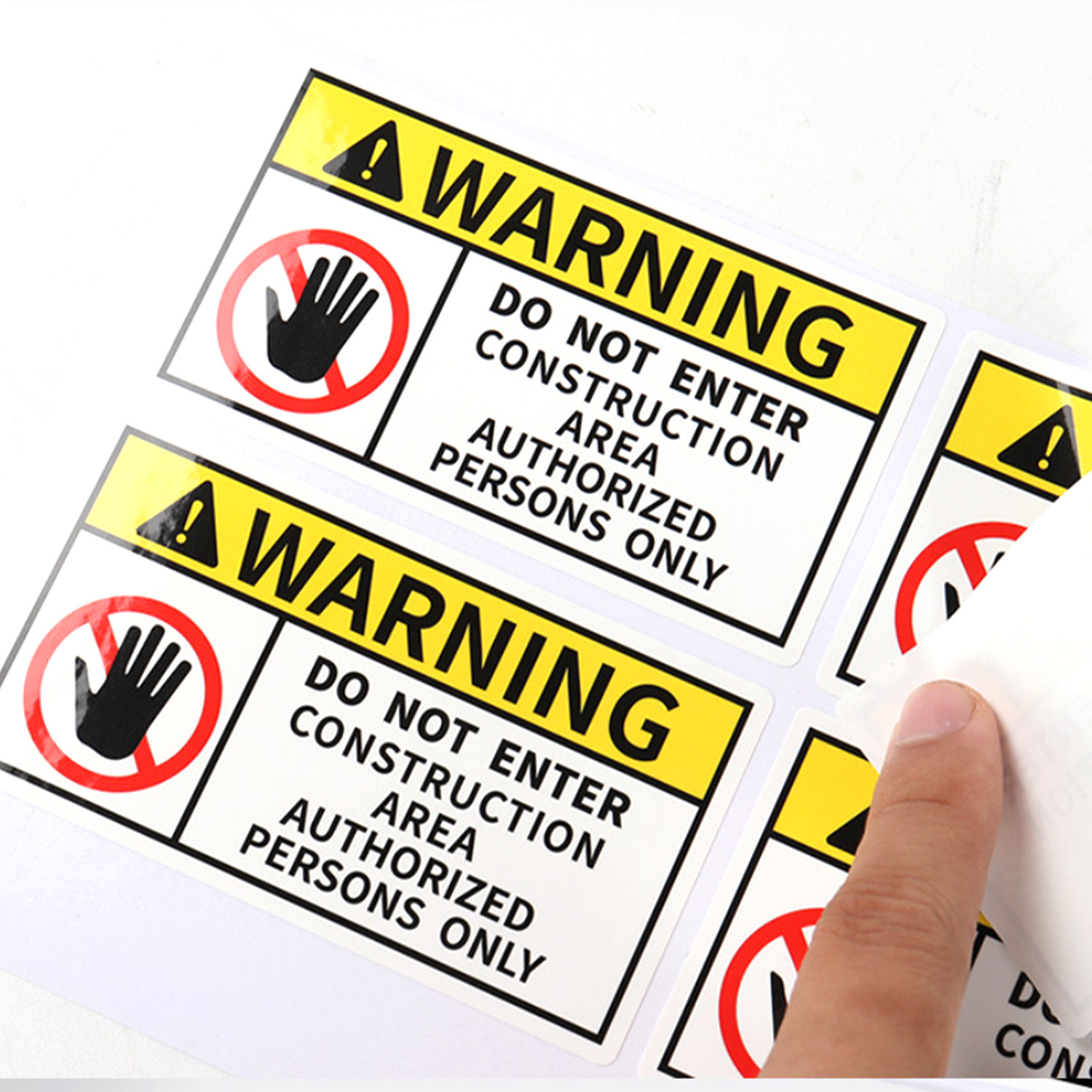
| Safety & Warning Labels | |
| Shape | Customized |
| Materials | PVC |
| Performance | Rainproof, Sunblock, Various Styles, Wear-Resistant |
| Colour | Pantone and RAL color matching system |
| Adhesive | Mobile Glue |
| Printing | Letterpress Printing, Digital Printing, PS Printing |
| Use membrane class | Glazing Film |
| Long-term Temperature Resistance | -25℃~100℃ |
| Thickness of Epoxy | 0.1~0.5mm |
What is A “Safety & Warning Label”?
Safety & warning labels are labels that express specific safety information to draw attention to risk factors. They usually include elements such as text descriptions, graphic symbols, and colors. It is used to warn of danger and clearly indicates the existing danger, such as high pressure, high temperature, flammable and explosive, so that people can take appropriate preventive measures.
Safety & warning labels use bold colors and graphic symbols to provide correct methods or steps to ensure that people are safe when using equipment or performing certain activities.
Features & Benefits of Safety & Warning Label Include:
Product Features
Visual significance: Excellent safety & warning label design can give people a strong visual impact, through contrasting colors and graphic symbols, to ensure that even in complex environments can quickly attract people’s attention.
Clarity of information: The information on the safety & warning label should be clear, specific, and easy to understand, including warning words (such as “danger”, “warning”, etc.), danger source information, possible consequences, and countermeasures.
Versatility and adaptability: The design of safety & warning label should be based on hazard sources, but should have a wide range of adaptability to meet the needs of different environments and scenarios. Whether it is industrial production, building construction or daily life, it is necessary to set up appropriate safety & warning labels according to the specific situation.
Standardization and standardization: Different industries and fields should follow the corresponding standards and specifications to design safety warning stickers to ensure their consistency and effectiveness.
Product Benefits
Improve Safety awareness: Safety & warning label can visually convey safety information and draw people’s attention to potential dangers, thereby improving people’s safety awareness. With eye-catching colors and graphic symbols, safety & warning label can quickly attract people’s attention and make people pay more attention to the surrounding environment and their own safety.
Prevent accidents: Effective safety & warning label can remind people to take appropriate precautions to avoid accidents.
Reduce accident losses: Once an accident occurs, the response measures and emergency contact information on the safety & warning label can guide people to take correct measures quickly, thereby reducing accident losses.
What Special Features Can Be Incorporated into Safety & Warning Label?
Multi-layer printing: Through multi-layer printing technology, different colors, patterns and text are superimposed on the safety & warning label to increase the layer sense and visual effect of the label.
Transparent cover: Add a transparent cover to the surface of the safety & warning label to protect the label from wear, scratching and chemical corrosion and extend its service life.
Personalized customization
Corporate identity: Add corporate identity or brand elements to the safety & warning label to showcase the corporate image and enhance brand recognition.
Industry-specific specifications: According to the safety specifications and standards of different industries, customize the content and design style of safety & warning label that meet the characteristics of the industry.
Environmental protection material
Recyclable materials: Choose recyclable environmentally friendly materials to make safety & warning labels to reduce environmental pollution and waste.
Low VOC materials: Materials that use low volatile organic compounds (VOCs) to reduce potential harm to the environment and human health.
Intelligent technology integration
Qr code link: Add a QR code to the safety & warning label. By scanning the QR code, you can link to detailed safety operation procedures, emergency treatment guidelines, or online training courses to provide users with more information and resources.
Smart sensors: In some high-end applications, smart sensors can be integrated into the safety & warning label to monitor the status of dangerous sources in real time and send alarm signals to improve the intelligent level of safety monitoring.
BX Panel Safety & Warning Label Technical Information
- Design phase
Determine the content: According to the features and Safety requirements of the safety & warning label, determine the information to be contained on the label, such as the product name, danger level, hazard description, preventive measures, first aid advice, and manufacturer information. Choose the right GHS (Globally Harmonized System) pictograms to visually communicate chemical hazards.
Design layout: Use professional design software (such as Adobe Illustrator, Photoshop, etc.) to create the preliminary design of the label. Ensure that all information is legible and complies with relevant regulations and standards (such as OSHA’s HazCom 2012 standards). Arrange the space on the label so that the information is orderly and easy to understand.
- Review and confirmation
Internal audit: Relevant departments or personnel conduct internal audit of safety & warning label design to ensure the accuracy and completeness of information. Check labels for compliance with company policies and regulations.
Customer validation (if applicable) : The design is presented to the customer for validation to ensure that it meets their specific needs.
- Prepare the printed document
Export file: Export the design file to a format suitable for printing (such as PDF, EPS, etc.).
Ensure file resolution and color patterns meet printing requirements.
Add necessary marks: According to the requirements of the printing plant, add the necessary printing marks such as bleeding lines and cutting lines.
- Preparation for printing
Select printing materials: According to the safety & warning label environment and durability requirements, select the appropriate printing materials and adhesive materials. These materials should be resistant to water, oil and chemicals.
Printing machine commissioning: The printing plant commissioning the printing machine to ensure printing quality and color accuracy.
- Printing process
Up-plate printing: Upload the prepared printing document to the printing press for up-plate operation. Adjust printing parameters as needed, such as ink volume, pressure, etc.
Quality control: Quality monitoring is carried out during the printing process to ensure that each label complies with the standard. Check the operation status and printing effect of the printing press regularly.
- Post-processing and inspection
Cut and fold (if applicable) : Cut and fold printed safety & warning labels to meet specific shape and size requirements.
Quality inspection:
Quality inspection of the cut safety & warning label to ensure that there are no defects, no printing and other problems.
Check that the information on the label is complete and accurate.
- Back adhesive
According to the use of the product environment and requirements, choose the appropriate type of back adhesive, such as waterproof, temperature resistance, super bonding, etc. We offer 3M, Crown, Soken, Nitto, Sony, Luxking and other adhesive brands.
What Industries Use Safety & Warning Label?
- Industrial manufacturing
Plant and shop floor: Safety & warning labels are used to identify hazardous areas, machinery, chemical storage areas, etc., in plants and workshops to remind employees to pay attention to safety and to follow operating procedures.
Mechanical equipment: On mechanical equipment, safety & warning label is used to indicate operation precautions, maintenance requirements, and potential hazards, such as high temperature, high pressure, and rotating parts.
- Construction Industry
Construction site: On construction sites, safety & warning label is used to identify dangerous areas (such as excavation areas and high-altitude working areas), safety exits, and emergency equipment (such as fire extinguishers and first aid kits) to ensure the safety of construction personnel.
Building materials: For certain potentially hazardous building materials (such as flammable and explosive materials), the safety & warning label is used to provide safety guidelines for storage, handling and use.
- Transportation
Transportation: On airplanes, trains, automobiles and other means of transportation, safety & warning label is used to mark safety information such as emergency exits, seat belt instructions, and no smoking.
Shipping cargo: For special cargo such as dangerous goods, inflammables, corrosive substances, safety & warning label is used to provide the correct packaging, handling and storage requirements to ensure safety during transportation.
- Energy and power industry
Power facilities: Around power facilities (such as substations and high-voltage pylons), safety & warning labels are used to warn people to stay away from dangerous areas and alert them to the risk of electric shock.
Energy production: In energy production sites (such as coal mines, oil fields, and natural gas processing plants), safety & warning label is used to mark flammable and explosive areas and toxic and harmful gas areas to ensure safety in the production process.
- Consumer goods industry
Food & Beverage: On food packaging, safety & warning labels are used to provide safety information such as ingredient information, allergen warnings, storage conditions, etc.
Toys and children’s products: On toys and children’s products, safety & warning labels are used to provide age recommendations, safe use instructions, and warnings of potential hazards.
- Public places and service industries
Hospitals & Clinics: In healthcare settings, safety & warning labels are used to indicate biohazard materials, radiation exposure risks, and other potentially hazardous areas.
Shopping centers and entertainment venues: In shopping centers, movie theaters, amusement parks and other public places, safety & warning label is used to indicate emergency exits, fire equipment locations and safety information.